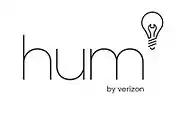Verizon Hum
Hum is a vehicle diagnostic and tracking system from Verizon Communications. The system is composed of two devices: a diagnostics reader which connects to a vehicle's OBDII and a speaker with Bluetooth connectivity that can be clipped to the visor.[1] A monthly subscription is required, but also includes a mobile application for reviewing collected data and receiving alerts as well as roadside assistance.[2] The Hum was first revealed in January 2015[1] under the name Verizon Vehicle,[2] but was rebranded before its release in August of that year.[3]
 | |
| Developer | Verizon Communications |
|---|---|
| Release date | August 26, 2015 |
| CPU | MODEM/Baseband processor + AP – VIA Telecom CBP8.2 |
| Connectivity | ODB II |
| Power | 1000mAh battery |
| Dimensions | Reader: 2.24" (H) × 1.90" (W) × 1.00" (D), Speaker: 4.45" (H) × 2.44" (W) × .90" (D) |
| Mass | 1.41 oz |
| Website | hum |
The initial product launch included features such as maintenance reminders, parking assistance, incident alerts, emergency assistance and stolen vehicle location assistance. In 2016 Verizon added location-based features that were marketed to parents as a way of keeping track of teen driving habits. The newer features allow users to set alerts for when the vehicle exceeds certain speeds or goes outside of set geographical boundaries (called geo-fencing).[4] A new model, Hum X, was launched in March 2017, featuring Wi-Fi hotspot capability, and priced at $15/month.[5]
References
- Rawlins, Peter. "Verizon Hum released, offering 'smart' features to legacy vehicles". The Stack. Retrieved 2 December 2016.
- Golson, Jordan (26 August 2015). "Verizon's 'Hum' Turns Any Clunker Into a Connected Car". Wired. Retrieved 4 December 2016.
- Geier, Ben. "Verizon's new gadget makes dumb cars smart". Fortune. Retrieved 2 December 2016.
- Morrison, Maureen (17 February 2016). "Verizon Wants To Help You Keep Tabs on Your Teens". Advertising Age. Retrieved 4 December 2016.
- "Verizon wants To Turn Your Car Into a Wi-Fi Hotspot". fortune.com. 2017-03-22. Retrieved 2017-04-19.